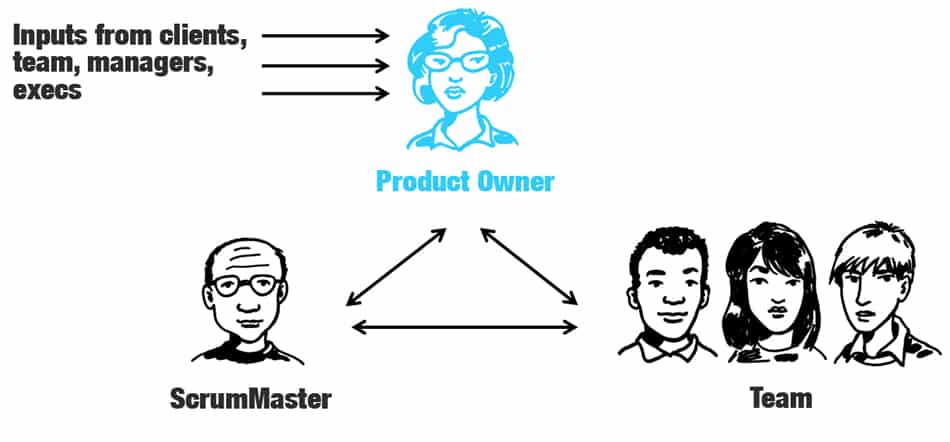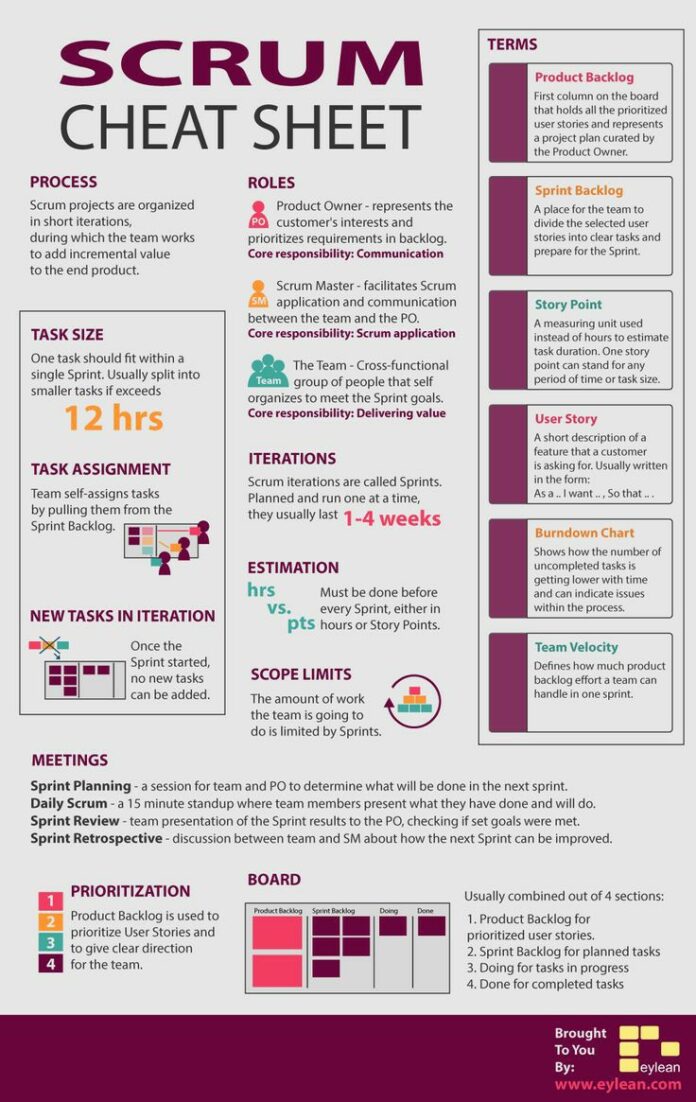Scrum is an agile-based framework that is used widely today to develop the most complicated products and systems. The name itself refers to the short meetings where members gather and talk about their achievements that are related to the project in hand. And also address the future challenges they will have to face. These meetings focuses mainly on the results members have came to.
To realize its importance, you need to realize how the agile development works. Agile itself isn’t a standard method of software development. It rather gives priority to the continuous achievements of the development of a set of iterative processes.
Agile Scrum in Project Management
There are three basic roles to a scrum project, those are:
- The Product Owner
- The Scrum Master
- The Scrum Team

1. The Product Owner Role
The product owner is the person that is responsible of the business side of the project. Basically, the one to talk to when the processes drift from the right order.
Since the Product Owner is a key player in the project, it is up to him or her to have a vision for the future. He also bears the responsibility of making that vision clear to the entire team. This is a crucial first stage in the Agile software development process, and it is often carried out using the product backlog. The product backlog is a list of tasks that must be completed throughout the course of the project, typically ordered in order of importance.
Only someone who has a thorough understanding of what end users want to see could assume the critical function of product owner. Regardless of who it is, whether from the marketing or product testing teams, they should be able to articulate what the users want from the project team. It’s crucial that the owner of the product understands potential trends in the market and what strategies or features rivals are using to obtain an advantage over them. But that also depends on the kind of product being developed (e.g. hardware or software).
You might also like: WHAT IS THE CRITICAL PATH IN PROJECT MANAGEMENT?
2. The Scrum Master Role
The scrum master role is to make sure all members of a team understand scrum and their roles in it. It’s more of a coach to ensure certain members of the team can implement the theory and practices of it.
As a facilitator, he aids the group in reaching agreement on what they are expected to accomplish within a given time range. Because he or she is required to take any action that will assist the team succeed, the Scrum Framework sees the Scrum Master as a servant leader. The SM’s job is to remove any barriers standing in the way of the team’s advancement in order to assist it in being the best it can be.
You might also like: WHAT ARE THE ROLES OF A PROJECT MANAGER
3. The Scrum Development Team
Only a dedicated team can implement a scrum framework. It usually consists of 6 members which include business analysts, software testers and of course, the developers.
They need to have the same goal, they must implement scrum rules and principles to fully achieve their goals of a specific sprint.
During daily stand-up meetings, members of the Scrum team are required to present their daily progress, along with any accomplishments and difficulties, to the Scrum team. The best performance from any new team typically takes two to three weeks to achieve; no new Scrum team ever produces a sprint that is entirely focused on the product increment. It requires time as members transition from being strangers to being a unified force and go through stages of getting used to working together.
You might also like: WHAT IS A BASELINE IN PROJECT MANAGEMENT
The Difference between Scrum Master and a Project Manager
In an Agile setting, there are several contrasts between the positions of Project Manager and Scrum Master. People frequently wonder if the project manager role is unnecessary given the Scrum Master position’s existence and the fact that the product development team is collectively accountable for any successes or failures.
The precise function of the project manager has long been a source of contention among the Agile community. The Scrum Master function and the Project Manager role are actually two completely distinct roles; keep in mind that the Scrum methodology is meant to be a departure from the conventional way of doing things.
In conventional project management, the project manager is viewed as the person in charge, the final decision-maker, and the person who bears the responsibility for any failures. He or she ensures that project goals are achieved and will be held accountable when things don’t go as planned.
We may claim that the Product Owner role and Project Manager function are quite comparable in this way (as opposed to the Scrum Master role). The Scrum Master should play a facilitation/coaching function; he is not to take decision actions or provide solutions to problems, according to a Scrum best practice. In contrast, the Project Manager may also make decisions and/or offer solutions.
The fact that project managers who support their organization’s transition to Scrum are a wonderful value to the organization does not change despite the fact that project managers have a tendency to perceive themselves as defenders of the conventional ways of doing things.
The typical project manager may feel out of place since it divides the traditional project management function among the product development team, the Scrum Master, and the product owner. This sense of dislocation is what leads to the large percentage of project managers that are against the Agile trend. Does that imply that in a Scrum environment, the project manager function is obsolete? The reply is, “Not always.”
The project manager’s function is one that radiates power—power over the team, power over the project, and power over the procedures. As a result, the creation of a training program is the first of a project manager’s duties when working in an Agile setting. The training course is important for the Scrum Methodology to be accepted and adopted more quickly. The project manager has the option of handling the training themselves or hiring outside trainers.
Prior to an organization implementing Scrum, it is the project manager’s duty to keep an eye out for Scrum team members who stray from the methodology owing to the temptation of ingrained habits. They have a responsibility to remind misbehaving team members that Scrum demands continual improvement because learning is a dynamic process and we can only learn by doing.
